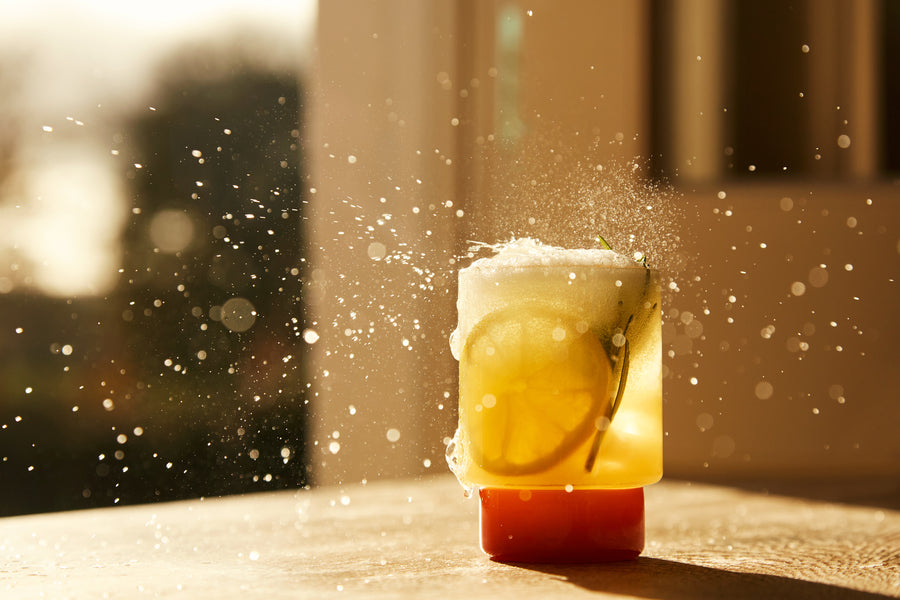Our love of fizzy drinks has no bounds. From the mousse-like texture in Champagne to the bright bubbles in soda water, we’re hooked. Artificial carbonation has been around since a man called Joseph Priestley discovered it in Leeds in 1767, but we’ve enjoyed the fizz of naturally carbonated drinks for much longer thanks to the process of fermentation. The likes of kombucha, fermented sweetened tea, fruit kvass made by fermenting rye bread and the Mexican fermented drink tepache made with pineapple cores and peelings, are some of the oldest fizzy drinks around.
Carbonation is a uniquely human taste, most other animals don’t like it. This is because CO2 is usually an indication of decay. Fruit and vegetables are covered with wild yeasts and bacteria and when they age, they react with the natural sugars in the food, and begin to ferment. It’s the fermentation that creates carbonation and then carbon dioxide, which our tongues can detect to help us realise when we’re eating food past its best.
But fizz doesn’t only add texture from bubbles bursting, it has a unique taste that adds to the overall flavour of drinks. Mountaineers who take pills to combat altitude sickness have reported their celebratory bottle of fizz at the summit tastes like dishwater. It has happened so often, it’s become known as Champagne Blues. But the reason for this flavour alteration has everything to do with the altitude sickness medicine they had taken.
Ready for some science? There’s an enzyme called carbonic anhydrase that sits on the surface of sour sensing cells on our tongue. It detects carbonation and converts the carbon dioxide into carbonic acid. It gives fizz its slightly sour taste. The altitude sickness pills are carbonic acid inhibitors, so basically they numb the tongue’s ability to detect the flavour of the fizz. Flat Coca-Cola or lemonade taste more sugary because they lack the sour fizz taste that helps reduce the sweetness.
But as well as a subtle sourness, carbonation has a burn or bite because carbon dioxide triggers pain sensors in the nasal cavity – the same ones that detect mustard and horseradish. You think this would prevent us from falling for the stuff, but it doesn’t. And the reason is most likely a psychological one. In the same way we ride roller coasters, bungee jump and challenge ourselves to eat spicy food, there’s an addictive quality to non-threatening thrills. We like to push our bodies to their limits.
So it’s a complex interaction of gas and bubbles in our taste system that draws us to fizz. But we wanted to get more detail on how different bubbles can change flavour. We chatted to recipe developer Luke Pearson of Pear & Sons, (read the full interview here) to find out more about the difference soda water or sparkling water can have on our Ginger Switchel. Luke explained, ‘Fizz can carry flavours and introduce a sharpness that flat water can’t. Bubbles also have an ability to exaggerate flavours, both good and bad. Carbonating unfiltered tap water on a kitchen gadget at home will bring out strong chlorinated flavours. Whereas a high-quality sparkling water with a wedge of orange will help highlight the bright citrus notes of the orange.’
Luke recommends trying different types of carbonated mineral water to find your preference, and in the Financial this week Alice Lascelles wrote an article on The Best Sparkling Waters in the World.
It seems we’re not the only ones giving more attention to the bubbles in our drinks. With Seltzers already having their moment, does our fascination with sparkling drinks continue in a new obsession with the intricacies, even terroir, within mineral water? Watch this space.
If you’re ahead of the game and have already picked out your favourite sparkling water to mix with Mother Root, let us know at hello@motherroot.london. We’d love to hear from you.
Back to all articles
Food and Drink
Can we taste fizz in sparkling drinks?
9th August '22




